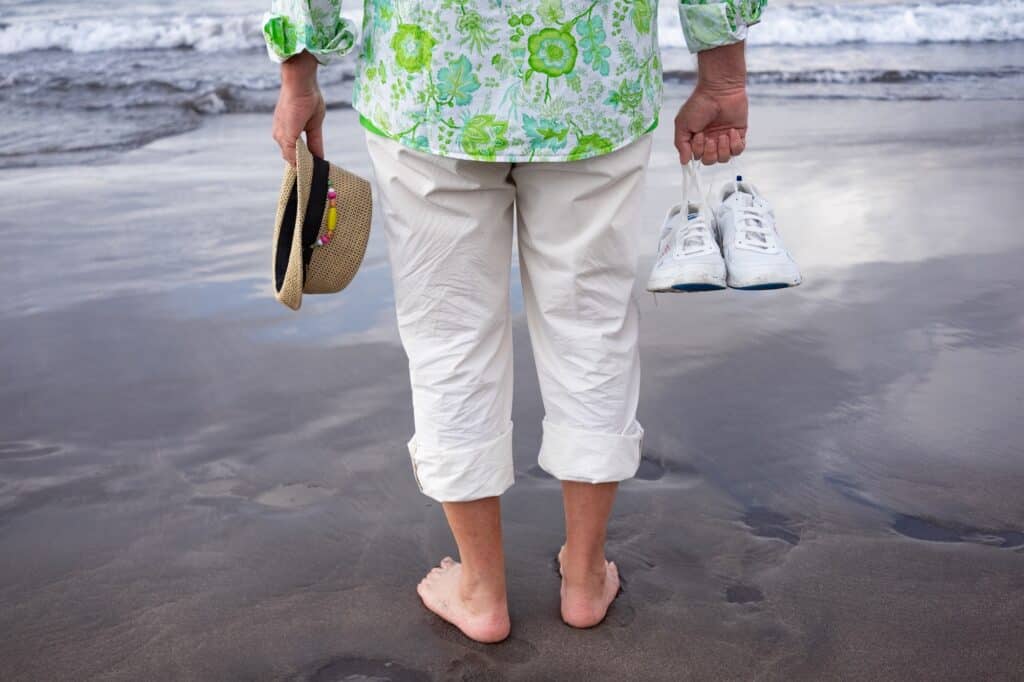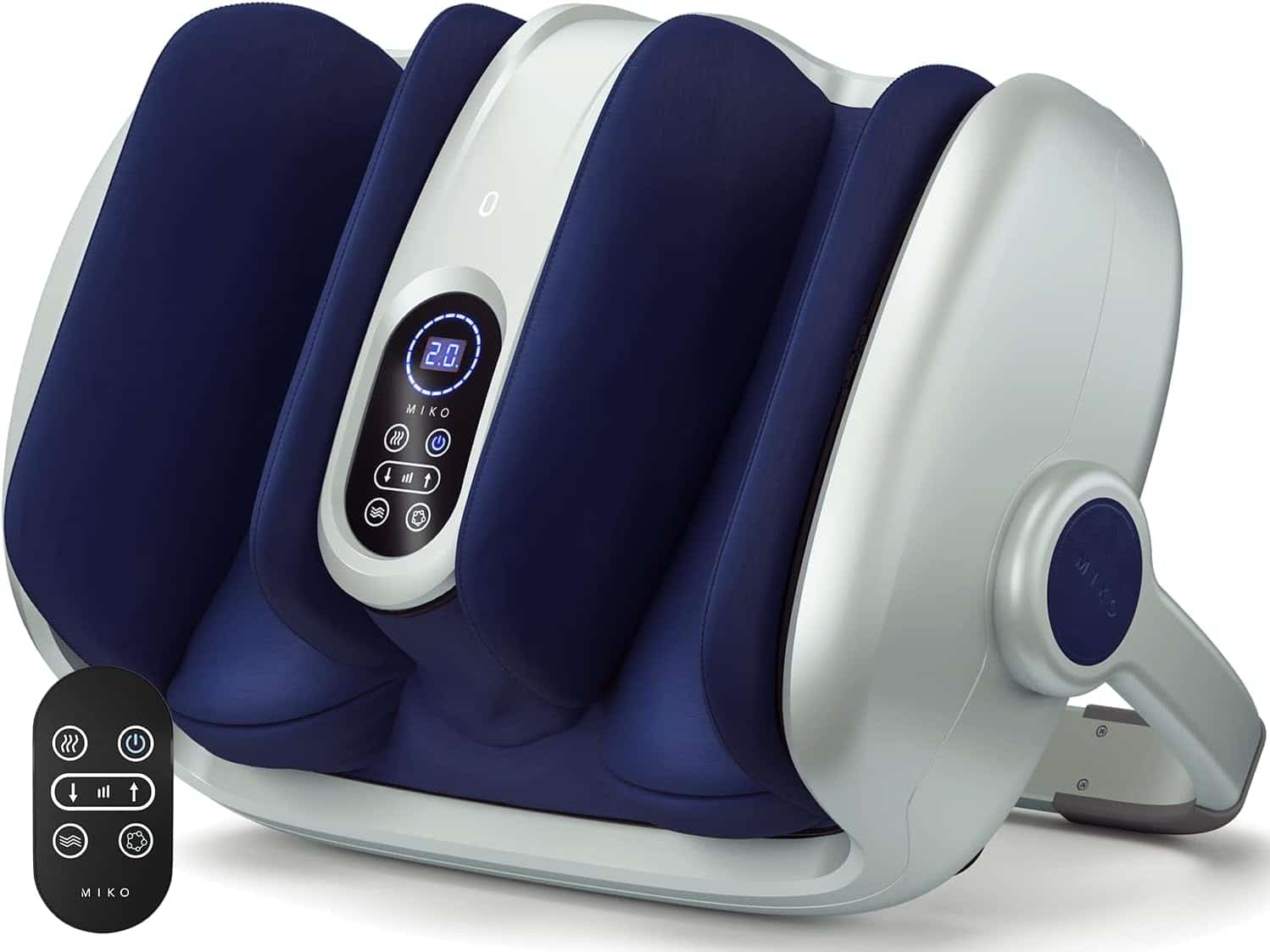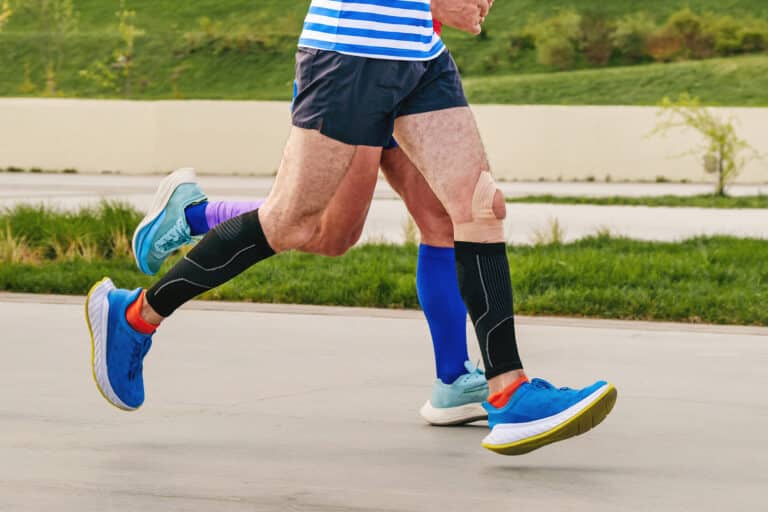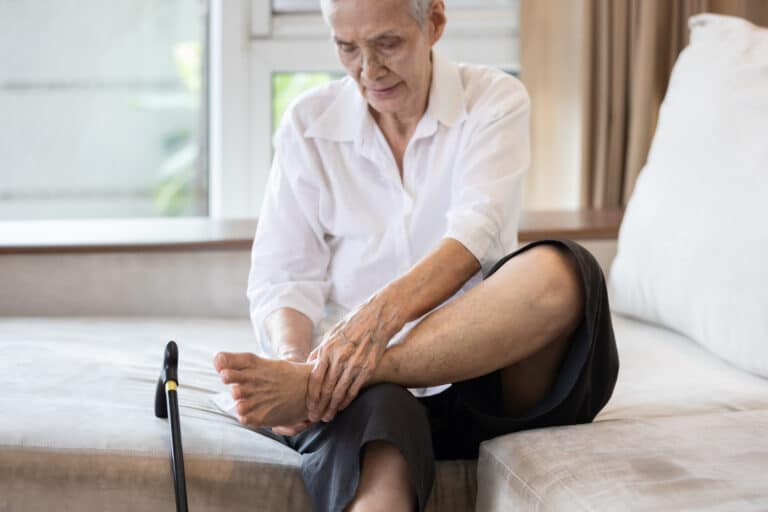Foot neuropathy is a common problem for seniors, and knowing how to manage this condition can be challenging.
While various factors can cause this problem and can significantly impact your daily activities and quality of life, there are exercises you can use to help improve the health of your feet.
Let’s explore some causes of foot neuropathy, how exercise can help you feel your best, and tips for maximizing your workout while managing foot neuropathy.
OUR SHOE RECOMMENDATION FOR NEUROPATHY: Orthofeet Yari Athletic Slip-On
What is Foot Neuropathy?
Foot neuropathy is a specific type of peripheral neuropathy, which describes damage to the nerves that connect your central nervous system to the rest of your body. Foot neuropathy directly affects the nerves that control sensation and muscles in your feet. (1)
Foot neuropathy can look different from person to person, but some of the common symptoms are numbness, tingling, burning, and pain in the feet and calf muscles. As foot neuropathy progresses, it can involve weakness and loss of balance or steadiness. (2)
This combination of sensation, strength, and balance problems can affect your quality of life and confidence during your daily activities.
Causes of Foot Neuropathy

There are many causes of foot neuropathy, but some of the most common are diabetes, alcoholism, and side effects from certain medications.
Diabetes
Diabetes is a complicated condition that impacts your body’s ability to regulate blood sugar. Some people are born with this condition, while others will develop it later in life due to their diet and lifestyle.
When diabetes results in high blood sugar for long periods, the nerves of the arms and legs can become damaged, causing gradual loss of nerve conduction and function.
Diabetes can be managed using exercise, diet changes, and medications that may help slow or stop the progression of neuropathy in your feet.3
Alcoholism
Alcohol has numerous effects on the brain and body, but it’s mainly a toxin that can damage many parts of our health.4
If you drink large amounts of alcohol regularly, the nerves of your body do not have enough time to recover from alcohol-related damage. In turn, normal signaling in your nerves will slowly become more impaired over time until symptoms of numbness and weakness begin to show.
Alcoholism is difficult; talk with your doctor if you have concerns.
Side Effects from Medication
When certain medications cause neuropathy, it is called drug-induced peripheral neuropathy. Common medicines that can cause neuropathy include cancer or cardiovascular drugs and antimicrobials. (5)
Talk to your doctor about your prescriptions regularly to ensure new medications do not impact your foot neuropathy.
How Exercise Improves Neuropathy
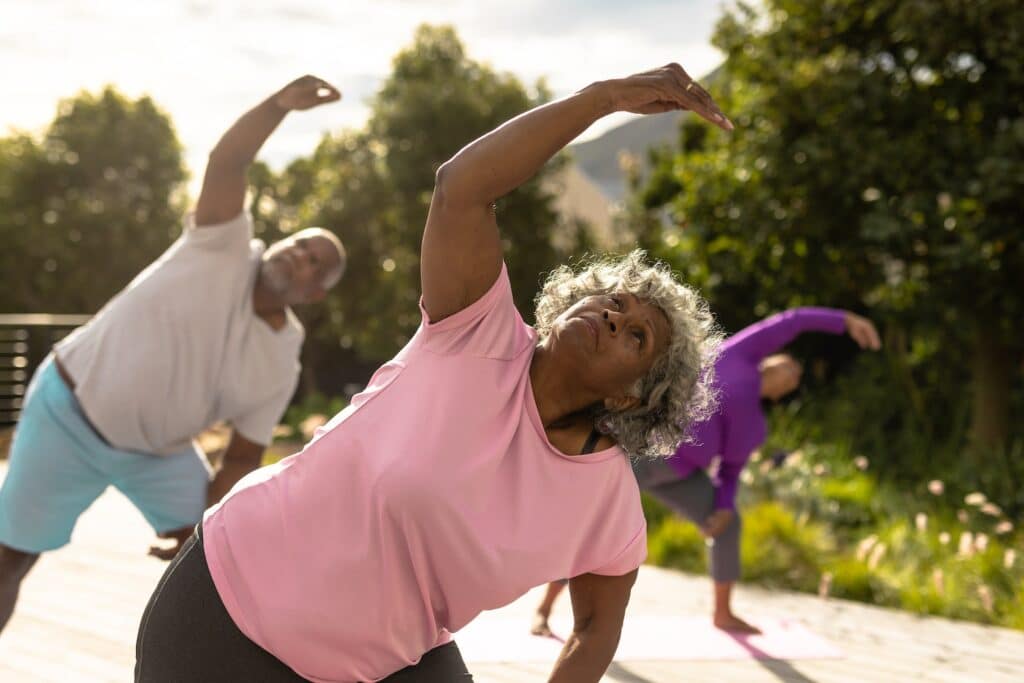
Exercise is a powerful tool for improving your symptoms of foot neuropathy. Exercising the muscles and nerves in your feet can help you improve balance, coordination, and confidence in your daily life. With the right precautions, exercise provides home remedies for neuropathy.
One significant benefit of foot exercise for neuropathy is increased circulation, which can help to reduce pain and improve nerve function in your feet.
When you exercise with your feet, ankles, and calves, the muscles surrounding your veins create a “pump” action that promotes blood returning to your heart. New blood can then enter your feet more often, providing your nerves with essential nutrients that help them function.
Simple Home Techniques to Manage Foot Neuropathy
The Value of Compression Socks
Compression socks play a vital role in managing symptoms of foot neuropathy. These socks work by applying gentle pressure to the feet and legs, which can significantly improve blood circulation.
Better circulation means more nutrients and oxygen are delivered to the affected nerves, potentially reducing symptoms like pain and numbness.
Additionally, the support and stability provided by compression socks can alleviate discomfort associated with neuropathy. They also serve as a protective measure, helping to minimize the risk of further foot injuries and complications.
Benefits of Shiatsu Foot Massages at Home
Incorporating shiatsu foot massage into home care routines can be highly beneficial for individuals with foot neuropathy. This type of massage focuses on applying pressure to specific points on the feet, mirroring the techniques used in professional therapeutic massages.
A Great Tool for Neuropathy You Can Use At Home
An important component of peripheral neuropathy treatment is movement and stimulation. Manual massage by a physical therapist helps to increase blood flow, reduce inflammation, activate the nerves, and encourage healing. Unfortunately, you probably can’t see your PT every day. That’s where the Miko Shiatsu Foot Massager steps in. The rolling massage action brings many of the same benefits of manual therapeutic massage, helping to relieve symptoms such as pain, numbness, tingling, and weakness sooner. It also provides gentle heat if desired, which is a supported modality in neuropathic healing. The open design allows treatment beyond just the feet, which can help with neuropathy that radiates into the ankles and calves. It’s a great device we recommend as another option for treating your foot neuropathy at-home as well as in the clinic.
Our recommendations are the same items we trust and prescribe to patients. When you buy through links like this on our site, we may earn an affiliate commission to support new content.
Regular shiatsu foot massages can help increase blood flow to the feet, decrease inflammation, and stimulate nerve function. These actions collectively contribute to pain relief and the healing process. Additionally, the warmth often associated with shiatsu massage can provide added comfort and aid in the relief of neuropathy symptoms.
Utilizing foot massage as a part of daily self-care can complement medical treatments, offering a convenient and effective way to manage the discomforts of neuropathy.
Three Exercises for Foot Neuropathy
Having the right exercise program is essential for getting the best results possible. Here are some easy exercises that can help improve your foot neuropathy symptoms.
Ankle Pumps
Ankle pumps are a beneficial exercise for foot neuropathy as they help promote circulation in the lower extremities, which is crucial for nerve health.
This simple yet effective movement encourages blood flow back toward the heart, reducing swelling and providing essential nutrients to the affected nerves. By actively moving the ankle joint, ankle pumps also aid in maintaining joint flexibility and muscle tone, which can be compromised due to neuropathy.
Regularly performing this exercise can alleviate symptoms like numbness and tingling in the feet while also helping to maintain mobility and reduce the risk of further nerve damage.
How To Do It Safely
Start by lying with your feet hanging off the edge of a table or sitting with your legs propped up in front of you.
Slowly “pump” your ankles by bending your foot toward your head as far as you can, then away from your body as far as you can.
For added difficulty, you can perform this exercise with your feet on the ground or while standing. Aim to complete 10-30 repetitions several times per day.
Towel Scrunches
Towel scrunches are an effective exercise for managing foot neuropathy as they actively engage and strengthen the small muscles in the feet, which are essential for maintaining foot structure and function.
This exercise enhances toe flexibility and agility, promoting better overall foot mechanics. Improved muscle strength and coordination in the feet can reduce neuropathy symptoms, such as pain and numbness, by improving circulation and nerve stimulation.
Towel scrunches can aid in developing finer motor control, which is often compromised in neuropathy, thereby improving balance and reducing the risk of falls.
How To Do It Safely
Start by sitting in a chair and placing a towel on the floor underneath one foot. Now, slowly curl the length of the towel towards your heel using only your toes, attempting to “scrunch” the towel up, moving it as far as you can without pain.
Hold this position briefly before you relax and return to the start. Repeat the exercise until your foot becomes fatigued, and aim to do this a few times daily.
Single Leg Balance
Single-leg balance exercises benefit foot neuropathy by enhancing balance and stability, strengthening lower limb muscles, and improving proprioception, which is often impaired in neuropathy.
These exercises also boost circulation, promoting nerve health and symptom reduction. Additionally, they increase confidence in movement and can be adapted for various fitness levels, making them a practical, versatile tool for managing foot neuropathy’s effects.
How To Do It Safely
Start by standing in front of a counter or wall with comfortable footwear or barefoot. Slowly remove one foot from the floor and begin standing on the remaining foot, keeping your foot flat.
Hold this position until your foot, ankle, or leg becomes fatigued—stop immediately if you are about to lose your balance or fall over.
You can make this exercise easier by keeping the toes of the lifted foot on the ground for added balance support or more challenging by closing your eyes. Remember to practice balance & foot exercises with a sturdy chair or nearby stable surface for safety.
Special Considerations for Exercises for Foot Neuropathy
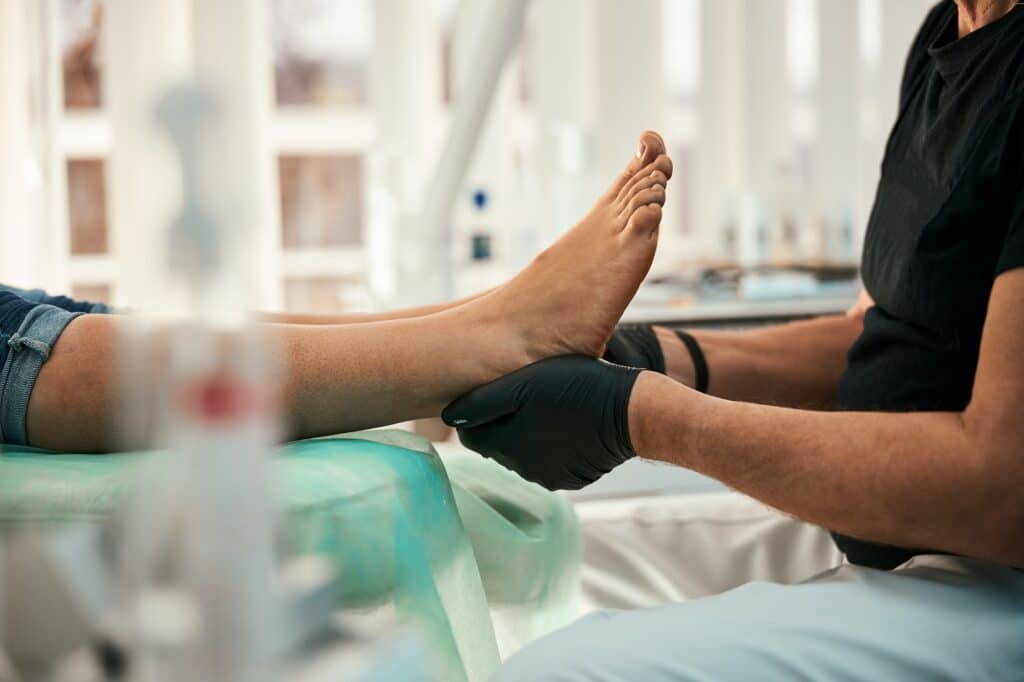
When exercising with foot neuropathy, there are a few things to consider for your safety:
- Start with gentle stretching and range-of-motion exercises, gradually increasing the intensity and duration of your activity over time. You may only realize you are causing damage the day after your workout when muscle pain intensifies.
- Avoid exercises like running and jumping that put excessive pressure or force on your feet. When you have limited sensation in your feet, it can be difficult to tell if you are hurting your feet during exercise. Additionally, check the bottom of your feet after trying a new activity to ensure no further injuries.
- Reduced foot sensation can impact your sense of balance and increase your fall risk. When you are performing an exercise that challenges your balance, make sure to stay close to a wall or counter. If you are concerned that you cannot practice balance exercises safely, work with a physical therapist who can supervise you for added safety.
As with any exercise program, talk to a doctor or physical therapist to determine the best exercise plan for your specific needs.
Key Takeaways
- Foot neuropathy is a specific type of peripheral neuropathy that affects the nerves in the feet, leading to symptoms like numbness, tingling, burning, and pain.
- The condition can significantly impact seniors’ daily activities and quality of life, and it often varies in presentation from person to person.
- Significant causes of foot neuropathy include diabetes, alcoholism, and side effects from certain medications.
- In cases of diabetes, prolonged high blood sugar can damage nerve conduction, leading to neuropathy.
- Alcohol consumption in large amounts can impair nerve signaling over time, eventually causing symptoms like numbness and weakness.
- Some medications, particularly those used in cancer or cardiovascular treatments, can induce neuropathy as a side effect.
- Exercise is beneficial for managing foot neuropathy, improving balance, coordination, and circulation, reducing pain, and improving nerve function.
- Specific exercises include ankle pumps, towel scrunches, and single-leg balance exercises.
- Compression socks and devices like the Miko Shiatsu Foot Massager can aid in managing symptoms.
- Special considerations for exercising with foot neuropathy include starting with gentle exercises, avoiding high-impact activities, and ensuring safety to prevent injuries and falls.
References
- Hyer CF, Lee TH, Philbin TM, Berlet GC. Diabetic neuropathy: the painful foot. Foot Ankle Clin. 2004;9(2):221-237. doi:10.1016/j.fcl.2004.01.002 https://pubmed.ncbi.nlm.nih.gov/15165579/
- What is Diabetes? (CDC). https://www.cdc.gov/diabetes/basics/diabetes.html
- Khan KS, Andersen H. The Impact of Diabetic Neuropathy on Activities of Daily Living, Postural Balance and Risk of Falls – A Systematic Review. J Diabetes Sci Technol. 2022;16(2):289-294. doi:10.1177/1932296821997921 https://www.ncbi.nlm.nih.gov/pmc/articles/PMC8861804/
- Facts About Moderate Drinking (CDC)
- https://www.cdc.gov/alcohol/fact-sheets/moderate-drinking.htm
- Jones MR, Urits I, Wolf J, et al. Drug-Induced Peripheral Neuropathy: A Narrative Review. Curr Clin Pharmacol. 2020;15(1):38-48. doi:10.2174/1574884714666190121154813 https://pubmed.ncbi.nlm.nih.gov/30666914/

